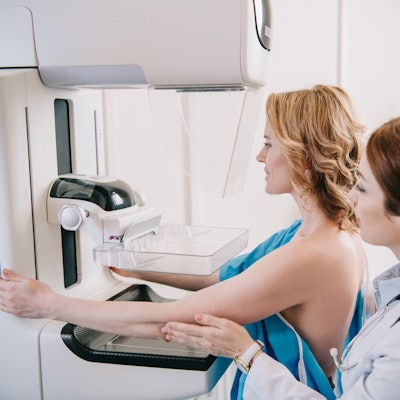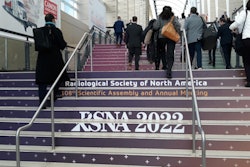
Mammography volume fell and a higher proportion of women presented with palpable masses during the COVID-19 pandemic at a Canadian breast center, according to a study published October 3 in the American Journal of Surgery.
On the positive side, the center was able to streamline its operations and reduce the amount of time women had to wait for a diagnosis. And there was no statistically significant difference in factors that could indicate more serious breast disease, like tumor stage, nodal status, tumor morphology, or biomarker status, said a team led by Dr. Gary Ko from the University of Toronto.
"The [center] enabled patients with concerning breast symptoms to access breast imaging, which helped to ensure timely treatment during the first wave of the pandemic," Ko and colleagues wrote.
The early days of the pandemic saw the temporary closing, or at least limited access, to breast cancer screening and diagnostic facilities. This led to missed or delayed mammograms for women everywhere, raising concerns that many women could end up presenting with more advanced disease.
While the long-term consequences of this sudden stoppage of breast cancer screening are still being determined, this didn't stop breast care centers from adjusting and strategizing. The University of Toronto team wanted to look at the pandemic's impact on patient volumes and treatment timing at the Gattuso Rapid Diagnostic Centre, established at the Princess Margaret Cancer Center in 2009.
The researchers described the center as a "one-stop shop" for breast cancer screening, diagnosis, and care. It was founded with the goal of reducing long waits at the hospital for a diagnosis, which were 37 days on average before the clinic's founding.
At the clinic, a clinical team that includes radiologists, pathologists, surgeons, and nurse practitioners guide patients through their diagnosis, with nurse practitioners facilitating appointments with in-house surgeons within 48 hours.
The clinic remained open during the pandemic, but to reduce potential exposure to COVID, it tried to reduce the number of hospital visits required of women, with the goal of prioritizing women who needed a biopsy so their workup could be completed in one visit.
Ko and colleagues looked at retrospective data from consecutive patients who presented at the center from March 2020 to August that same year. The data was compared with the same period in 2019.
Women are "generally" eligible to be referred to the clinic if they had breast imaging showing a BI-RADS 4 or 5 breast lesion or a palpable breast mass that had not been biopsied. For this study, women who underwent a biopsy with a new diagnosis of stage 0 to 3 breast cancer were included.
Measures the center adopted during the pandemic included triaging consults and prioritizing patients who did not have outside imaging requiring review. This allowed for more time when triaging patients who may have needed a biopsy based on referral to ensure an entire workup in one visit, the study authors wrote. The center also created "add-on" slots for women seen in breast imaging who needed a biopsy. The researchers wrote that this sped up the pathology and ensured appropriate consultation.
On the negative side, the number of women being seen at the facility dropped 18.6% during the COVID pandemic, and the number of women presenting with a palpable abnormality went up, from 43.1% to 53.4%. But on the positive side, the clinic was able to reduce the amount of time it took for women to receive a diagnosis after the first abnormal image was acquired.
| Comparison of rapid diagnosis center breast cancer presentation for 2019, 2020 | ||
| 2019 | 2020 | |
| Patients seen | 527 | 429 |
| Women presenting with palpable abnormality | 43.1% | 53.4% |
| Time from first abnormal image to diagnosis | 25.9 days | 17.4 days |
| Women presenting with imaging abnormality | 56.9% | 46.6% |
In other findings, the researchers saw a change in the mix of technologies used during the pandemic period.
| Change in breast imaging technologies used during COVID-19 pandemic | ||
| 2019 | 2020 | |
| Mammography | 67% | 77.4% |
| Supplemental breast MRI | 27.7% | 35.7% |
| Ultrasound-guided core biopsy | 60% | 44.8% |
| Stereotactic core biopsy | 11.6% | 9.3% |
| MRI-guided biopsy | 3% | 5.8% |
The study authors acknowledged that while the reduced patient volume may have contributed to shorter wait times, they added that workflow changes during the pandemic may have also led to the reduction.
Ko et al also noted a lower proportion of women at the center were diagnosed with breast cancer during the first six months of the pandemic compared with the similar time frame the year prior. They wrote that this was because women presented to the center with breast symptoms during the pandemic period who would have otherwise been assessed by their family physician and had breast imaging at external facilities.
"Since our radiology group does not routinely repeat mammograms, patients with benign findings would not usually be referred to the center for further investigation if patients had been able to access breast imaging," they wrote.



















